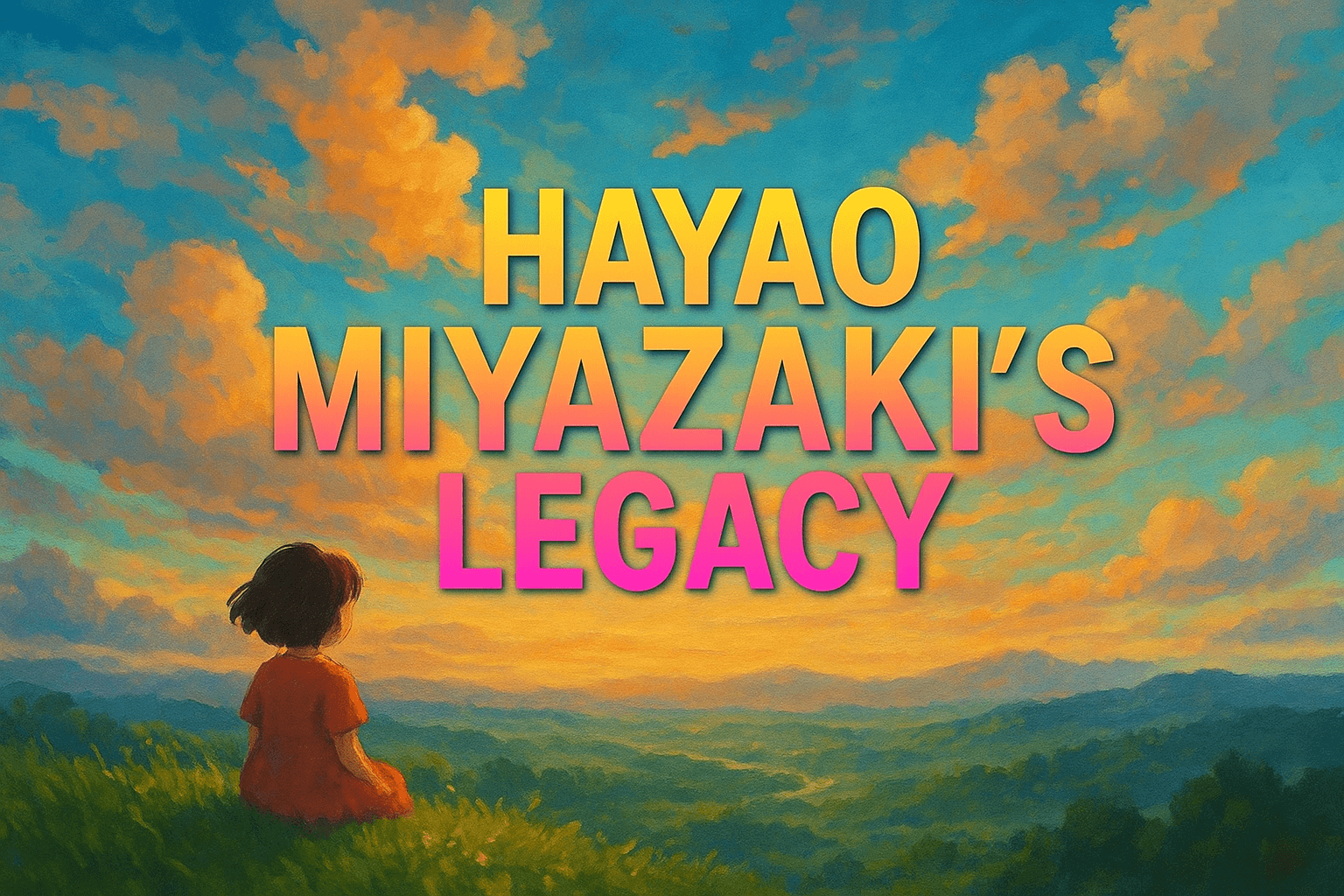Hayao Miyazaki’s Legacy: The Strategic Blueprint for Global Animation Success (2025)

Introduction
The enduring influence of director Hayao Miyazaki and Studio Ghibli extends far beyond animated feature films; it represents a comprehensive, non-traditional content strategy that M&E executives must analyze.
This is not simply a discussion of artistry; it is an examination of an operational model that achieved unprecedented Hayao Miyazaki’s Legacy of commercial and cultural longevity by prioritizing creative integrity over mass-market trends.
The Studio Ghibli model serves as a strategic counter-narrative to volume-based production and transient trends, offering C-suite lessons on long-tail IP monetization, disciplined production sourcing, and building an authorial brand that transcends cultural barriers.
The current global media landscape, characterized by content saturation and the pressure to quickly feed platform algorithms, has only amplified the strategic value of Miyazaki’s decades-long approach.
His methodology—a commitment to hand-drawn craft, thematic consistency, and stringent distribution control—has resulted in an IP library whose value appreciates over time.
The key takeaway for senior leaders is that creative scarcity and uncompromising quality are not bottlenecks but strategic differentiators in the modern entertainment supply chain.
Table of content
- The Strategic Power of Auteur Branding and IP Longevity
- The Production Discipline: Hand-Drawn Craft as Strategic Differentiator
- Mastering Long-Tail Monetization: A Blueprint for Cross-Border Licensing
- The New Co-Production Paradigm: Vetting Partners Beyond Price
- Hayao Miyazaki’s Legacy in the Age of AI and Supply Chain Pressure
- How Vitrina Helps Operationalize the Strategic Lessons of Studio Ghibli
- Conclusion: The Enduring Strategic Value of Creative Authenticity
- Frequently Asked Questions
Key Takeaways
| Core Challenge | The M&E sector struggles to build IP with cultural longevity that appreciates rather than depreciates in value. |
| Strategic Solution | Adopt a high-integrity, auteur-driven “content engine” model that ensures thematic consistency and controlled global distribution. |
| Vitrina’s Role | Providing the market intelligence platform required to vet partners based on creative track record and align co-production deals with strategic, high-integrity models |
The Strategic Power of Auteur Branding and IP Longevity
In a market dominated by franchise IP and committee-driven decision-making, Studio Ghibli operates as a masterclass in Auteur Branding. The company successfully operationalized the single creative vision of Hayao Miyazaki and co-founder Isao Takahata into a prestige label.
This is a model that M&E leadership can apply to their own content divisions: transforming a strong creative perspective into a predictable, high-value brand promise for audiences and distributors alike.
The brand’s commercial success is fundamentally tied to its thematic consistency. Ghibli films consistently explore universal themes like the relationship between humanity and nature, the complex experience of adolescence, and the power of peace over conflict. By baking these ideas into its DNA, the studio created a recognizable product that requires minimal marketing to establish its value proposition.
This thematic coherence is the bedrock of IP longevity, providing a constant source of cultural relevance and syndication opportunities for decades, a process that is far more capital-efficient than relying on constant, expensive IP reboots.
The Anti-Hype Model: Scarcity as a Marketing Tactic
One of the most counterintuitive strategic lessons is Ghibli’s historic reliance on scarcity. For years, the studio employed a “poster-only” marketing strategy, relying entirely on the reputation of the creative team and the brand itself rather than pre-release trailers or expensive digital campaigns. This secrecy-first approach created intrigue and built a profound trust with the audience, a form of intellectual property that cannot be bought.
Furthermore, the studio was famously hesitant to license its films for streaming, only agreeing to split global rights (with Netflix acquiring international rights outside the US/Japan and Max securing domestic streaming) in the late 2010s/early 2020s (Source 3.4).
This discipline of keeping the content scarce for decades meant that when it finally entered the digital marketplace, it did so as an immediately valuable library, commanding significant fees and drawing in subscribers.
This content monetization strategy is the direct opposite of the standard streaming playbook, proving that creative integrity can fuel commercial longevity, according to analysis by Vitrina AI (Source 1.6).
Transcending Borders: Why Ghibli’s Themes Travel
The universality of the themes is the engine for cross-cultural appeal. While the animation is distinctly Japanese, the narratives bypass niche cultural references in favor of archetypal human experience.
This is a crucial lesson for acquisition and co-production executives seeking content that can succeed across diverse international territories without requiring extensive localization of the core narrative.
The films were designed to be ready for global export, with the “no-edits” policy enforcing a level of creative control that protected the original artistic vision from market pressures
The Production Discipline: Hand-Drawn Craft as Strategic Differentiator
In an era where animation production is frequently outsourced, digitized, and optimized for speed, Ghibli’s steadfast commitment to traditional, hand-drawn methods represents a clear-cut case of production discipline as strategic differentiation. This choice is not an act of nostalgia but a deliberate, high-risk operational decision that has yielded unique intellectual property.
The Inefficient Advantage: Rejecting Mass Production for IP Uniqueness
Studio Ghibli’s production pipeline is notoriously labor-intensive, often leading to extended timelines, as noted in a review of their process (Source 4.1). However, this “inefficiency” is precisely what creates the unique visual IP that cannot be replicated by automated or scale-focused studios.
The resulting films have a painterly quality, an attention to detail in the depiction of food, weather, and motion (known as ma or “gaps in action”), that defines the brand.
For a production executive, this highlights an essential strategic truth: while cost savings through volume production are tempting, true, long-term IP value comes from proprietary style and uncompromising craft.
The Studio Ghibli brand equity is directly proportional to its production discipline. The hand-drawn aesthetic acts as a defensive moat against competitors seeking to imitate their success.
When evaluating production sourcing, executives should prioritize vendors and partners whose proprietary methods, even if more resource-intensive, create an aesthetic barrier to entry for mass-market imitators.
A Pipeline Built on Creative Integrity, Not Speed
Miyazaki is famous for eschewing finished scripts, often storyboarding films in an organic, evolving process (Source 4.1). This approach ensures that the narrative and creative vision are not constrained by a fixed document, allowing the story to “feel alive and unpredictable.”
While this runs counter to common studio practices centered on rigid deadlines and predictable delivery schedules, the outcome is content that achieves a timeless quality, ensuring a long shelf-life in the distribution and licensing market by maintaining high creative value.
This model suggests that strategic investment in creative flexibility during development can be a greater long-term asset than speed-to-market.
Mastering Long-Tail Monetization: A Blueprint for Cross-Border Licensing
The journey of Ghibli’s films, from initial theatrical releases decades ago to their current multi-platform streaming deals, provides a vital framework for media executives focused on maximizing long-tail revenue.
The primary strategic decision was maintaining control over the IP’s value and timing its market entry in a staggered, value-maximizing manner.
The Evolving Distribution Strategy: From Disney to Split Streaming Rights
Ghibli’s international distribution began with a key partnership: an agreement with The Walt Disney Company in 1996, which made Disney the sole international distributor for the Tokuma Shoten-owned Ghibli films (Source 1.1). This deal immediately gave Ghibli global prestige and access to Disney’s powerful marketing and distribution apparatus.
Years later, the studio masterfully segmented its distribution rights to optimize platform revenue and market penetration:
- Split Streaming Deals: The decision to grant Max exclusive U.S. streaming rights and Netflix global rights (excluding Japan/US) created a high-value, region-specific revenue stream for the library (Source 3.2, 3.4). This strategy ensured competitive bidding for a limited, high-demand catalog, proving that controlled scarcity is an executive-level negotiating asset.
- The GKIDS Acquisition: In a significant market signal, Japanese entertainment giant Toho acquired GKIDS, the long-time North American distributor for Studio Ghibli films, in 2024 (Source 3.3, 3.5). This move underscores the immense, enduring value of the Ghibli catalog and demonstrates a strategic interest by a major studio to internalize control over key foreign distribution channels. For content executives, this acquisition validates the idea that owning and controlling the distribution of high-integrity IP, even post-retirement of the auteur, is a premium long-term asset.
The Critical Role of Metadata in Rights Management
Underpinning this complex, multi-territory, multi-platform licensing model is the operational necessity of accurate, centralized metadata. In a fragmented global supply chain, managing which films are licensed to Max, which to Netflix, and which remain under local theatrical distribution requires disciplined rights tracking. The value of the Hayao Miyazaki’s Legacy library is directly contingent on the precision of its business metadata, including:
- Clear rights holders (post-Nippon TV acquisition of Studio Ghibli)
- Territory-specific distribution windows and expiry dates
- Verified co-production and financing entities for revenue split
This highlights the strategic importance of content Project Tracker platforms like Vitrina for real-time visibility, allowing executives to monitor licensing opportunities and competitive content movements across every major market.
The New Co-Production Paradigm: Vetting Partners Beyond Price
The Ghibli model enforces a co-production and partner selection philosophy that challenges the typical M&E priority of lowest cost. It is a system built on creative and ethical alignment, not merely transactional efficiency.
Aligning Creative Ethos: The Ghibli Model for Partner Selection
Miyazaki and Studio Ghibli have maintained their reputation by vetting partners on their respect for the creative product. The famous “no-edits” clause, enforced globally after the heavily edited U.S. release of Nausicaä of the Valley of the Wind in the 1980s, is the ultimate example of this. When partnering with global distributors, Ghibli selected those who would respect the integrity of the work (Source 1.1).
For co-production executives, this is a lesson in de-risking a project through reputation. By identifying potential partners whose track record reflects a similar commitment to quality and creative control, one minimizes the risk of brand dilution or market erosion down the line. When conducting cross-border transactions, reputation and credentials are the primary currency, not volume capacity.
The Acquisition Trail: Toho’s Move on GKIDS as a Market Signal
Toho’s acquisition of GKIDS is a clear signal that the value of an aligned distribution partner is paramount. The Japanese giant recognized that merely licensing the films abroad was less valuable than controlling the market access through a trusted, proven entity. This strategic move highlights a trend in the M&E supply chain: the internalization of high-performing, niche distribution assets.
Co-production strategy must now factor in the long-term acquisition viability of partners. For executives scouting for potential creative collaborators—whether in animation, post-production, or co-financing—it is essential to analyze the historical partnership network and M&A potential of the target company.
Finding animation co-production partners in diverse markets is complex, but the Ghibli example shows that finding the right partner with shared values is the primary driver of IP value for global success.
Hayao Miyazaki’s Legacy in the Age of AI and Supply Chain Pressure
The final challenge and lesson posed by Hayao Miyazaki’s Legacy is its confrontation with the current demands of the supply chain: the pressure for speed, the push for AI-driven efficiency, and the need to scale production. His model offers a framework for maintaining value amidst technological disruption.
The Ethical Line: Creative Integrity vs. AI Mimicry
The rise of generative AI tools that can mimic the “Ghibli style” (often termed ‘Ghiblification’) directly challenges the value of unique artistic discipline.
Miyazaki himself has expressed strong reservations about AI-generated art, seeing it as an “insult to life itself” (Source 1.3). For M&E executives, this is not merely a philosophical debate; it is a question of intellectual property protection and brand definition.
When derivative content can be generated instantly, the market value of the truly original and human-crafted work—the “Auteur Branding” that Ghibli perfected—appreciates dramatically.
The strategic mandate is to define where a company draws the ethical and legal line on AI usage, ensuring that production cost savings do not erode the very creative integrity that drives long-tail value. The Ghibli case serves as a legal and ethical precedent that executives must monitor as they formulate their AI governance policies.
Operationalizing the “Ghibli Model” for M&E Executives
While few organizations can fully replicate the operating constraints of Studio Ghibli, the core principles can be operationalized into a strategic roadmap for contemporary M&E leaders:
- Centralize Discovery Across Markets: Use dedicated market intelligence to track emerging auteurs and content creators whose work demonstrates the potential for Ghibli-like IP longevity. The focus must shift from simply finding available content to identifying “prestige labels” in the making.
- IP Library Due Diligence: Prioritize content that exhibits deep thematic consistency and clear localization readiness. Ensure content metadata is meticulous to support complex, long-term, multi-territory licensing strategies.
- Partner Vetting: Treat production discipline as a strategic asset. Vet partners not just on speed or price, but on their proven commitment to creative excellence and their alignment with the IP’s core ethos. This reduces the risk of long-term brand damage in the pursuit of short-term efficiency.
How Vitrina Helps Operationalize the Strategic Lessons of Studio Ghibli
The strategic blueprint laid out by Hayao Miyazaki is about achieving cultural impact and financial longevity through disciplined decision-making. Vitrina is the market intelligence platform engineered to execute this discipline.
The Ghibli model’s success rests on knowing: who the next visionary is, who to partner with, and how their project is moving through the global supply chain. This level of precise, entity-based tracking is Vitrina’s core mission.
Vitrina provides the verified data and tools needed for M&E executives to move beyond transactional, volume-based strategies toward high-integrity, value-maximizing partnerships. We track over 300,000 film and TV projects and millions of executive-level contacts across the global supply chain. By using the Vitrina platform, M&E leaders can:
- Find High-Integrity Auteurs: Use advanced entity search to discover and vet directors, producers, and studios based on their verified creative track record, genre focus, and past collaborators, identifying “auteur brands” before they become industry giants.
- De-Risk Co-Production: Move beyond simple financial metrics. Instantly map co-production partners based on their creative ethos and reputation, rather than merely their production capacity or location.
- Master Licensing Strategy: Access the Project Tracker for real-time visibility into project development, production stage, financing, and key personnel, ensuring that content acquisition and distribution decisions are based on the latest, most complete data.
Vitrina transforms the fragmented global supply chain into a single, verifiable source of truth, enabling the strategic precision required to build an IP portfolio with the enduring value of Hayao Miyazaki’s Legacy.
Conclusion: The Enduring Strategic Value of Creative Authenticity
The story of Studio Ghibli and Hayao Miyazaki’s Legacy is a powerful case study for the entire Media & Entertainment supply chain.
It teaches that the deliberate choice of creative integrity, production discipline, and controlled scarcity is not a liability—it is the single greatest guarantor of enduring commercial success.
For executives navigating an over-saturated, algorithm-driven, and AI-challenged market, the path forward is clear: build a content engine that creates unique, culturally resonant IP that defies both trend and time.
By implementing a high-discipline, data-supported framework for talent discovery, production sourcing, and rights management, M&E leaders can move their companies from chasing short-term volume to cultivating long-tail, generational value.
Frequently Asked Questions
Miyazaki’s “no-edits” policy is a non-negotiable term in licensing agreements that forbids distributors from altering the content of a film, including editing scenes, cutting footage, or changing the runtime. This policy was put in place after the heavily edited U.S. release of Nausicaä of the Valley of the Wind and is designed to protect the creative integrity and artistic vision of the auteur.
Studio Ghibli intentionally restricted the availability of its films for decades, refusing to allow them on streaming services or make them widely accessible for home video for long periods. This created controlled scarcity and cultural value, meaning when the content was eventually licensed to platforms like Netflix and Max, it commanded a premium fee and generated significant, long-term revenue.
Production discipline, as demonstrated by Studio Ghibli’s adherence to hand-drawn animation, creates proprietary, visually unique IP that is difficult and costly for competitors to replicate. This aesthetic differentiation acts as a brand defense, ensuring the product’s quality and uniqueness are preserved, which in turn fuels long-term IP value and reduces the risk of brand dilution.















































